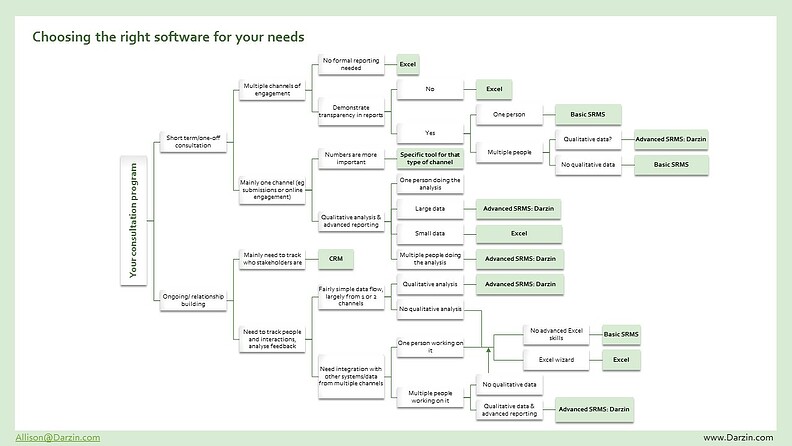

Do you need a Stakeholder Management Software?
Not sure if you really need stakeholder management software? We’ve put together some facts to help you decide if stakeholder management software is the right solution for your project or organisation.
Stakeholder management software certainly isn’t for everyone – it all depends on the features and functionality you need, and how important stakeholder management or engagement is within your organisation.
So let’s talk a bit more about the kinds of organisations who commonly purchase stakeholder management software, the key benefits, alternative options and risks of not buying. Plus, we’ll touch on standard pricing so you know what to expect, and how you can get started if software is the right choice for you.
What kinds of organisations use stakeholder management software?
- Stakeholder management software is essential in any organisation where engaging, managing or consulting with stakeholders is required under legislation or needed to drive outcomes.
- Industries that commonly practice stakeholder management include:
- Government
- Infrastructure
- Energy and water
- Utility
- Mining
- Oil and gas
- Healthcare
What are the benefits of buying stakeholder management software?
- In a nutshell, buying stakeholder management software helps your team save time and manage stakeholders better by helping you be more organised and automating manual processes.
- But let’s get more specific on the features and how they can add value:
- Increased security – Unlike operating out of a spreadsheet, stakeholder management software allows you to choose who has access to what information, and whether they can updated it.
- Task management – Help your team stay organised and take action at the right time with built-in task management. This includes reminders and notifications so they can keep up-to-date even with a busy schedule.
- Track contact information – Provide your team with a clear “home” for all their stakeholder management activities, including stakeholder contact information. When you have this info in software, it’s easy to collaborate and share up-to-date information, without worrying about version control.
- Track communication – Record every interaction with your stakeholders in one place so all the right people on your team can access it. Plus, ensure you have a record of any complaints, corrective actions and commitments so you stay compliant and on top of things.
- Manage events – Make it quick and easy to invite stakeholders to meetings, track your attendees, and record minutes. And attach any event-related data to the relevant stakeholder contact information and staff who need to take action.
- Collect data – Most stakeholder management software allows you to collect data via forms, native surveys or survey software integrations. This is essential for collecting feedback from stakeholders, collecting personal data, collecting online submissions and then evaluating your progress towards objectives.
- Analysis – Some stakeholder management programs (like Darzin) offers advanced analysis tools like open text response analysis (qualitative) and quantitative data analysis (like issue trends and key statistics).
- Reporting – Easily report on your data and analysis with a stakeholder management tool that automatically generates reports for you that are easy to interpret and turn into action steps. That way, you ensure you never collect data just for the sake of it.
- Of course, the specific features and benefits will depend on the type of stakeholder management software you purchase – we’re basing these off Darzin’s features as we’re leaders in stakeholder management and analysis software. But most other stakeholder software has at least some of the above features.
What are some alternative stakeholder management systems?
- While stakeholder management software comes with a lot of benefits, it’s not for everyone. If you’re a small organisation or running a small-scale stakeholder management approach, you may be able to use a more basic stakeholder management system. There are two main alternatives you could consider.
- Excel spreadsheets – most small businesses start here and then import their data into stakeholder management software as they scale up. There are a few reasons why most organisations outgrow excel spreadsheets:
- Version control is difficult when managing stakeholders as a team
- Storage and sharing may not comply with GDPR
- The functions are extremely basic – it’s just for storing straightforward data, so you miss out on time-saving automations and integrations
- Sometimes it can be more time consuming as you have to maintain records (such as meeting minutes, survey responses) in multiple systems.
- You can’t easily run sentiment analysis and issues management in a spreadsheet.
- CRMs – some customer relationship management tools do have a lot in common with stakeholder management software, and for some organisations, they’re sufficient for storing contact details, tracking communication and task management. But they’re designed for sales, not managing stakeholders. So you’ll miss out on useful features and integrations like collecting feedback, understanding issues, and analysing data.
- If you’re not sure whether you’re ready for stakeholder management software, you can always start with a spreadsheet or CRM and then upgrade when you’re ready. But it’s important to realise that any other solution is a compromise on:
- Time – it’ll take you and your team longer to find what you’re looking for and make any updates needed
- Security – you risk storing personal details and important information in a less secure way, and potentially breaching some of the legislation around personal data security and use
- Speed – you’ll likely respond slower to inquiries and events
- Functionality – fewer integrations and automations mean you’ll be able to collect less stakeholder-specific data, and do less with the data you can collect
- Read more about alternative stakeholder management systems and the differences between CRMs , spreadsheets, and purpose-built stakeholder software.


How much does stakeholder software cost?
- Price is nearly always a factor when considering stakeholder management software. You’ll need to look for a software package that has the features you need and fits within your budget.
- You won’t find pricing details on websites, as most companies provide a custom quote for each enquiry. Most of the well known stakeholder management software providers cost around $25-$45K per year, but fees can be $100K+ depending on what you need.
Darzin offers the most power stakeholder management software on the market for a competitive price, with multiple licencing options to suit one-off projects, organisations and governments, so please don’t hesitate to get in touch if you’d like to request a quote.

